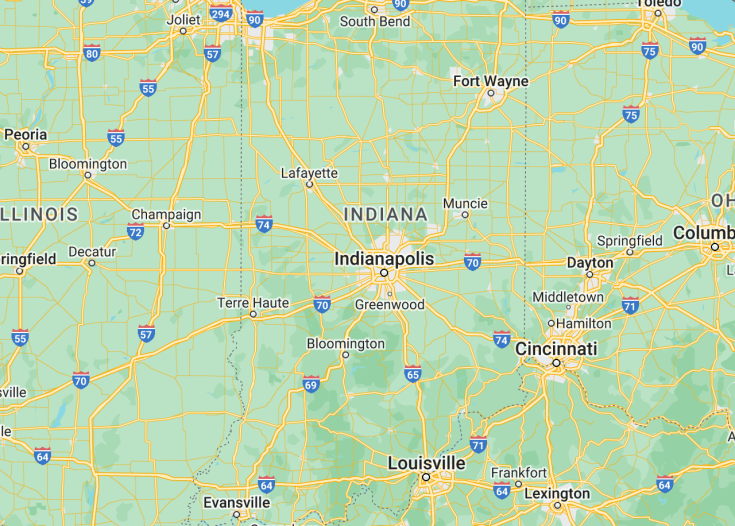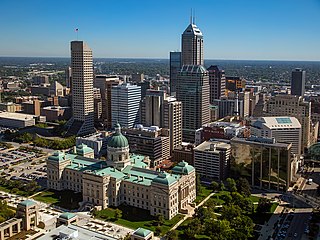Nestled in America’s Midwest, Indiana, affectionately known as the “Hoosier State”, is a blend of history, culture, and natural beauty. With a rich tapestry of landscapes, from the serene dunes of Lake Michigan to the rolling hills of Brown County, Indiana promises distinct experiences. Its urban hubs like Indianapolis boast vibrant arts scenes and iconic motor racing, while its rural expanses provide tranquil retreats. Offering a genuine slice of Americana, Indiana welcomes travelers with a harmonious balance of metropolitan energy and pastoral charm.
For sports enthusiasts, a visit during the Indianapolis 500, a legendary car race, is a must.
Explore beyond the cities; small towns like Nashville, IN offer artisan shops and picturesque views.
Top destinations in Indiana (USA)
Indiana: the crossroads of America
| Capital | Indianapolis |
| Time in Indiana (USA) | GMT -5 |
| Language spoken | English |
| Population | 6,785,528 (source: United States Census Bureau) |
| Religion | Christianity (76.7%) Protestantism (53.7%) Catholicism (16%) No Religion (16.9%) Other Religions (6.4%) |
| Currency | United States Dollar (USD) |
| Airports | Indianapolis International Airport Fort Wayne International Airport South Bend International Airport Evansville Regional Airport |
Indiana, often referred to as the “Hoosier State”, holds a significant place within the tapestry of American history and culture. Nestled in the Midwest, this state boasts a blend of industrial, agricultural, and cultural richness. From its early Native American inhabitants to its pivotal role in the nation’s westward expansion, Indiana has witnessed a dynamic evolution. The state has been home to visionaries, artists, and leaders who have left indelible marks on its landscape. Its cities like Indianapolis echo with the roar of car engines, paying homage to its deep-rooted love for racing, while its serene countryside offers tales of bygone eras, pioneering spirits, and the timeless beauty of the American heartland.
Where is Indiana located?
Indiana is located in the Midwest region of the United States. It is bordered by Lake Michigan and the state of Michigan to the north, Ohio to the east, Kentucky to the south, and Illinois to the west. Its central location makes it easily accessible from various parts of the country.
What is Indiana famous for?
Indiana is famous for several reasons. It is home to the iconic Indianapolis 500 race, one of the most prestigious motorsport events in the world. The state is also known for its rich basketball tradition and is often referred to as the “Hoosier State.” Indiana is proud of its agricultural heritage, offering extensive corn and soybean fields. Additionally, the state is known for its beautiful national parks, such as Indiana Dunes National Park, where visitors can explore sand dunes and enjoy the scenic Lake Michigan shoreline.
History
Prehistoric Era: Ancient Peoples and Cultures
The region now known as Indiana was inhabited thousands of years before the arrival of Europeans. Ancient peoples such as the Adena, Hopewell, and Mississippian cultures left a lasting legacy in the form of earthworks and artifacts. These societies thrived due to the fertile lands and abundant resources, leaving traces of their existence which are still studied today.
1600s – 1700s: European Exploration and Native Relations
European exploration in Indiana began in the 1670s with French explorers such as René-Robert Cavelier, Sieur de La Salle who established trading posts. For years, the French developed a relatively peaceful relationship with the Native American tribes, primarily the Miami and Potawatomi. However, British influence grew in the region, leading to territorial disputes. In 1763, as a result of the Treaty of Paris, control of the region transferred from France to Great Britain.
Late 1700s: American Revolution and Territorial Era
Indiana played a role in the American Revolutionary War, with key events such as George Rogers Clark’s capture of British posts. Following the war, in 1783, the region was ceded to the United States. The subsequent years witnessed increasing American settlement, leading to tensions with Native American tribes. The Battle of Fallen Timbers in 1794 and the Treaty of Greenville in 1795 were significant events marking U.S. consolidation in the area. Indiana became part of the Northwest Territory and, later, the Indiana Territory in 1800.
Early 1800s: Statehood and Development
Indiana’s population grew rapidly in the early 19th century, leading to its admission as the 19th state of the Union in 1816. The state’s economy began to flourish with the advent of canals, railroads, and improved roadways. The construction of the Wabash and Erie Canal boosted trade and connectivity. The state also took progressive steps in education, leading to the foundation of institutions such as Indiana University in 1820.
Mid to Late 1800s: Civil War and Industrial Growth
Indiana played a crucial role during the Civil War, siding with the Union and contributing significantly in terms of manpower and resources. Post-war, the state underwent a major industrial transformation. The discovery of natural gas in the late 19th century further propelled its industrial activities, making cities like Indianapolis hubs of economic activity.
20th Century: Wars, Social Change, and Modernization
Indiana’s contributions continued in the World Wars, with many Hoosiers serving in the military and the state’s industries aiding the war efforts. The 20th century also witnessed significant social changes, including the Civil Rights Movement. Indiana, like many other states, grappled with issues of segregation and inequality. Economic diversification, with a focus on manufacturing, agriculture, and services, led to stable growth. The establishment of the Indianapolis 500 motor race in 1911 added to the state’s cultural and sporting legacy.
21st Century: Contemporary Era
Today, Indiana stands as a blend of its rich historical past and modern advancements. It is renowned for its contributions to education, sports, arts, and industries. Challenges such as economic shifts and social issues are addressed with a forward-thinking approach, keeping in mind the Hoosier spirit of resilience and innovation.
Visit Indiana
What to see and do in Indiana
Indiana offers a variety of attractions and activities for visitors to enjoy. From historic sites to natural wonders, there is something for everyone to explore. Here are some must-see destinations in Indiana:
- Explore the Indiana Dunes National Park, a beautiful stretch of sandy beaches and towering sand dunes along the shores of Lake Michigan.
- Visit the iconic Indianapolis Motor Speedway, home of the Indianapolis 500 and Brickyard 400 races.
- Discover the history of the state at the Indiana State Museum, which features exhibits on topics ranging from Native American culture to the Civil War.
- Experience the vibrant arts scene in Bloomington, home to Indiana University and a thriving music and theater community.
- Take a trip back in time at Conner Prairie, an interactive history park that recreates 19th-century life in Indiana.
These are just a few examples of the many attractions and activities Indiana has to offer. Whether you’re interested in history, nature, sports, or the arts, Indiana provides a diverse range of options for visitors to enjoy.
Events in Indiana
Indiana hosts a variety of events throughout the year, showcasing its rich culture and heritage. Here are some notable events that take place in Indiana:
- The Indiana State Fair, held in Indianapolis each summer, features agricultural exhibits, live entertainment, and a wide variety of food.
- The Indy 500 Race, held on Memorial Day weekend, is one of the most prestigious auto racing events in the world.
- The Covered Bridge Festival, held in Parke County each autumn, celebrates the state’s historic covered bridges with arts and crafts, food vendors, and live entertainment.
- The Indiana Statehood Day Celebration, held on December 11th, commemorates the state’s admission to the Union with special events and activities.
These events provide opportunities for visitors to immerse themselves in Indiana’s culture and traditions. Whether you’re interested in agriculture, racing, history, or local crafts, there’s an event in Indiana that’s sure to appeal to you.
Best time to visit Indiana
The best time to visit Indiana is during the spring and fall seasons when the weather is mild and pleasant. Spring brings blooming flowers, while fall offers vibrant foliage colors. These seasons also coincide with many of the state’s festivals and events, providing visitors with a chance to experience Indiana’s culture and heritage. The summer months are also popular for outdoor activities and attractions like the Indiana Dunes National Park and the Indianapolis Motor Speedway. However, summers can be hot and humid, so it’s important to plan accordingly. Winter can be cold and snowy, but it provides opportunities for sports like skiing and ice skating. Overall, Indiana offers something unique and enjoyable in every season, so the best time to visit depends on personal preferences and interests.
Is Indiana worth visiting?
Indiana is definitely worth visiting for those seeking a blend of natural beauty, cultural attractions, and historical significance. The state offers diverse landscapes, from the stunning shores of Lake Michigan in the north to the rolling hills and farmlands in the south. Its rich history is reflected in its numerous historical sites and museums, allowing visitors to delve into the past and gain a deeper appreciation for the region. Additionally, Indiana’s vibrant cities offer a mix of art, music, and sports, providing plenty of entertainment options. While it may not be as well-known as some other destinations, Indiana has a lot to offer and is a hidden gem worth exploring.













